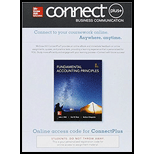
Concept explainers
Concept Introduction:
Ending Work in Process of the departments:
The ending work in process of the department can be defined as the units left in the department after the units are transferred to the next department from the total available units. Total available units are the sum of units in the beginning and the units started in the process.
The ending work in process of the department can be calculated as under –
Ending work in process = Beginning Direct Materials + Beginning Conversion cost + Cost added for Material + Cost added for conversion – Transferred to the next department
To Determine:
Ending work in process inventory accounts for –
1. Cutting Department
2. Binding Department
Want to see the full answer?
Check out a sample textbook solution
Chapter 20 Solutions
Connect 2-Semester Access Card for Fundamental Accounting Principles
- I need assistance with this financial accounting question using appropriate principles.arrow_forwardCan you solve this financial accounting problem using appropriate financial principles?arrow_forwardI am looking for the correct answer to this financial accounting question with appropriate explanations.arrow_forward
- Can you solve this financial accounting question with the appropriate financial analysis techniques?arrow_forwardCan you solve this financial accounting question with accurate accounting calculations?arrow_forwardI need help with this financial accounting problem using proper accounting guidelines.arrow_forward
- Can you explain the correct methodology to solve this financial accounting problem?arrow_forwardCan you help me solve this financial accounting question using the correct financial procedures?arrow_forwardI need guidance with this financial accounting problem using the right financial principles.arrow_forward

 AccountingAccountingISBN:9781337272094Author:WARREN, Carl S., Reeve, James M., Duchac, Jonathan E.Publisher:Cengage Learning,
AccountingAccountingISBN:9781337272094Author:WARREN, Carl S., Reeve, James M., Duchac, Jonathan E.Publisher:Cengage Learning, Accounting Information SystemsAccountingISBN:9781337619202Author:Hall, James A.Publisher:Cengage Learning,
Accounting Information SystemsAccountingISBN:9781337619202Author:Hall, James A.Publisher:Cengage Learning, Horngren's Cost Accounting: A Managerial Emphasis...AccountingISBN:9780134475585Author:Srikant M. Datar, Madhav V. RajanPublisher:PEARSON
Horngren's Cost Accounting: A Managerial Emphasis...AccountingISBN:9780134475585Author:Srikant M. Datar, Madhav V. RajanPublisher:PEARSON Intermediate AccountingAccountingISBN:9781259722660Author:J. David Spiceland, Mark W. Nelson, Wayne M ThomasPublisher:McGraw-Hill Education
Intermediate AccountingAccountingISBN:9781259722660Author:J. David Spiceland, Mark W. Nelson, Wayne M ThomasPublisher:McGraw-Hill Education Financial and Managerial AccountingAccountingISBN:9781259726705Author:John J Wild, Ken W. Shaw, Barbara Chiappetta Fundamental Accounting PrinciplesPublisher:McGraw-Hill Education
Financial and Managerial AccountingAccountingISBN:9781259726705Author:John J Wild, Ken W. Shaw, Barbara Chiappetta Fundamental Accounting PrinciplesPublisher:McGraw-Hill Education





